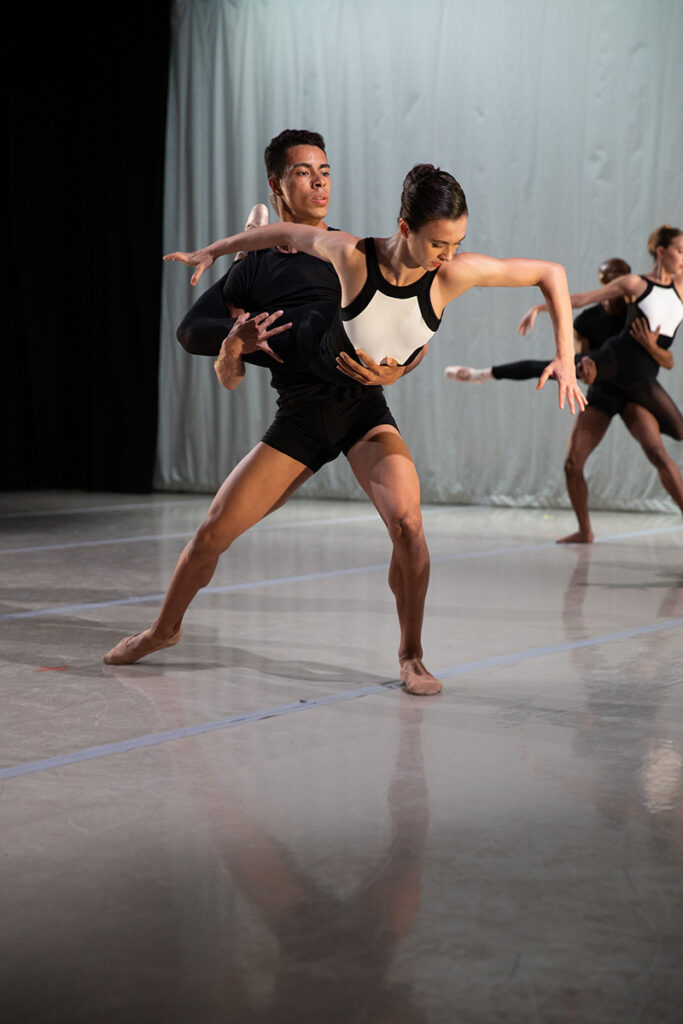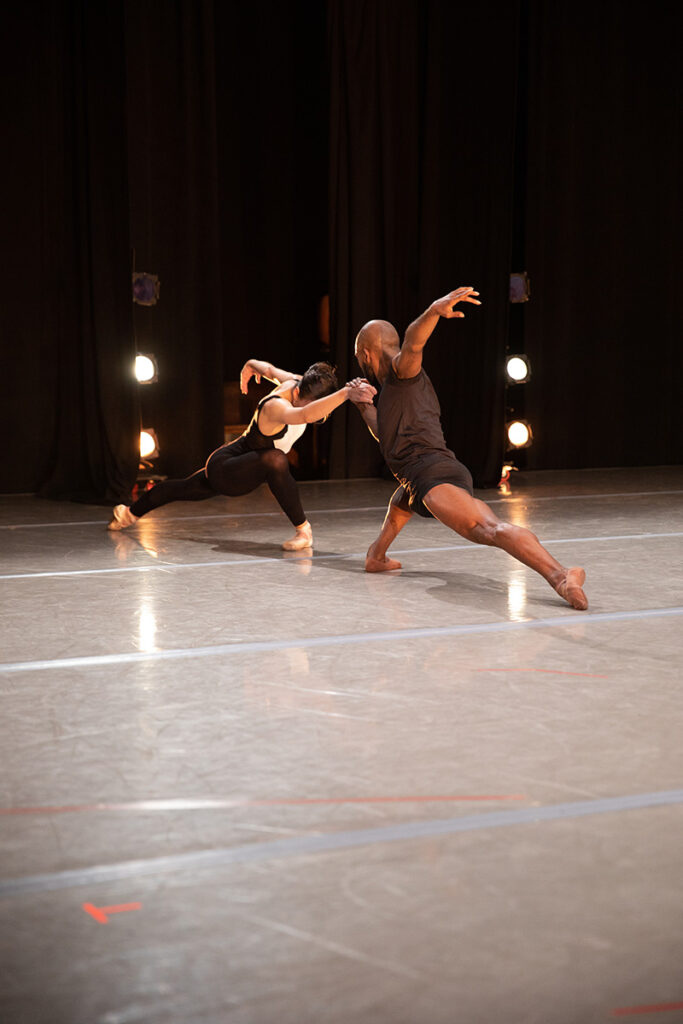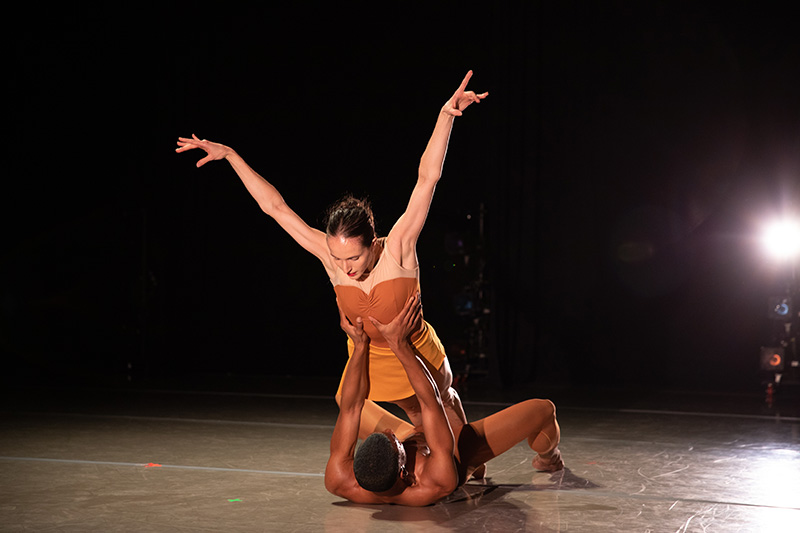Breaking the Ballet Mold to Inspire Change
BY BONNIE EISSNER
The daylight was fading from the windows of the fifth-floor Manhattan studio as Morgan McEwen, the founding artistic director of MorDance, and seven dancers worked through the steps of the ballet the company would perform in just a few weeks. Late in the rehearsal, McEwen demonstrated some steps she had envisioned, narrating as she went. Something like: arabesque, pirouette, chassé, bird arms.
Bird arms?
With that last term, she hunched her shoulders and extended her arms as if lifting enormous wings. She maintained grace even as she countered the conventions of ballet—curling her back, thrusting her arms out at sharp, avian-like angles.
But McEwen and her dancers were practiced at making bird shapes with their bodies. They had spent a weeklong retreat in Martha’s Vineyard embodying birds, and specifically the albatross—the giant seabirds whose wings can span up to 11 feet.
At the end of April, McEwen will premiere her new dance, simply called Albatross, at the Gerald W. Lynch Theater at The City University of New York’s John Jay College of Criminal Justice (supported by a CUNY Dance Initiative residency). To pull it off, to make an awkward bird beautiful, McEwen and her dancers must stretch the boundaries of ballet. But that’s why McEwen got into choreography in the first place.

From Albatross, Photo by Meredith Lawrence
Ten years ago, while dancing for the Metropolitan Opera ballet, McEwen realized she wanted to do more than dance other people’s dances. She was ready to choreograph her own.
“So often people are asking, ‘Why is ballet an art form where half of the audience is over 50?’” McEwen said. “I think when you’re telling stories that aren’t relatable, you’re alienating a large portion of the audience that would be interested in the art form.”
With just over $12,000 in crowdsourced seed funding, she started her own nonprofit ballet company.
Finding her find her voice, though, took a few years.
“I think, really, I started trying to find that around our fifth season,” she said, “and now I’m all forces blazing.”
Last November, about 100 ballet enthusiasts filled the seats in the Martha Graham Studios in New York to preview Albatross and Emily, a ballet inspired by Emily Dickinson’s poetry that will also premiere in late April. There was little white hair in the audience, and that wasn’t a fluke. The company has attracted students and people under 40 who are interested in its works and can afford the $20 to $30 tickets, McEwen said.
In Albatross, McEwen blends the weightlessness of ballet with gravity-bound elements of modern dance to depict the seabirds who soar and mate amid the looming threat of the plastic-polluted waters from which they feed their young.
The dance is loosely based on Chris Jordan’s eponymous documentary about the albatross colony at Midway Island whose chicks are dying at alarming rates from ingesting plastic debris. McEwen had been seeking art that captured how mass consumption affects the planet, and when she saw Jordan’s film, she knew she had to translate it into a ballet.
In choreographing the dance and collaborating with composer Josh Knowles, she fulfilled the filmmaker’s wish not to devastate audiences but to stir their sympathy and awe for the threatened birds.
Four female dancers en pointe are paired with four males. Albatrosses mate for life, and the dancers alternate between intimate paired dancing and moving together as a flock. The dancers simulate the birds’ years-long flights away from land with outstretched arms, swaying bodies, and, especially for the women dancers, dramatic lifts, and plenty of turns and leaps. Tenderness and innocence tango with melancholy in the piece, which is set to Knowles’ score of looping and distorted violin music. The blend of legato and staccato adds a dystopian air to the work.

From Albatross, Photo by Meredith Lawrence
For the second new dance, Emily, McEwen drew inspiration from Dickinson’s 1862 poem “They Shut Me Up in Prose” about her escape from an intolerant society into her imagination.
“This is a woman that wasn’t heard,” McEwen said. “I look at myself in my early career, and I think as a young dancer, I was never really heard. I was a body in a studio doing what I was told to do.”
The eight-person dance is set to searing music for piano and strings composed by Polina Nazaykinskaya. In a movement that evokes the sentiments of the poem, a dancer playing Emily is pushed, shoved, and kicked by the seven other dancers.
Yet the five-part ballet is not only about a woman artist being stifled. It has evolved into a depiction of a woman growing up and finding her voice. McEwen found inspiration for the different movements, she said, in the life stages and experiences of her mother, grandmother, and her two-year-old daughter.
“The world is her oyster right now,” McEwen said, describing her daughter. “No one is silencing her. She’s just there. She’s so free and unaware. … If we all had it when we were adults, I think it would be truly incredible.”

From Emily, Photo by Meredith Lawrence
McEwen hopes to be a role model for other young women. “I have never had a female boss my entire career,” she said. “I’ve only danced ballets by maybe five women my entire career. I think it’s important for people to see people that look like them in these roles.”
She added, “I think representation is important in all ways.” She wants to attract a young, diverse audience and seeks to mirror that diversity in her dancers. The troupe includes several dancers of color and dancers who identify as queer and non-binary.
McEwen considers ballet a platform for instigating change.
“I think ballet is one of the most incredible art forms there is,” she said. “I think it has the power to tell incredible stories. I think it has the power to educate people. I feel it has the power to unite people.”
Her new works show that a decade into leading her company, she is realizing this vision.
~~
To learn more, visit www.mordance.org.

2 Responses to “Breaking the Ballet Mold to Inspire Change”
Thanks Diana!
Kudos to Morgan McEwen. Such ventures take courage, perseverance, and creativity. How to draw out an audience with a ballet like Albatross and engage the viewer’s souls to reflect is a gift. I’ve often longed to see the well-trained ballet body stretched beyond tutus and sparkling crowns. It sounds as though McEwen is doing that.
Comments are closed.